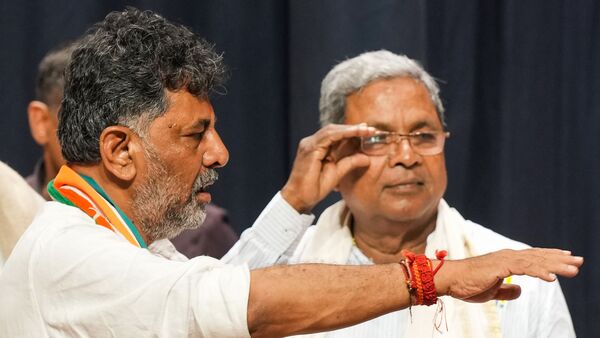He emerged as a hero when the Congress won the Karnataka election last Saturday after he campaigned in blistering heat to sharpen the party’s messaging. Despite being jailed recently, and facing a money-laundering case from the Enforcement Directorate and a corruption case from the CBI, he still won his eighth consecutive assembly election that day.
Any follower of the leader would normally celebrate such a victory, but many Shivakumar followers aren’t celebrating. A chief ministerial standoff between him and his colleague Siddaramaiah was eventually resolved on Thursday, after several sleepless nights of strategising and countless meetings with the national leadership. Shivakumar lost out to Siddaramaiah and will have to settle for the deputy CM post.
A drowsy Shivakumar appeared underwhelmed while confirming the decision. “I dreamt (for the CM post). I desired. I dedicated. I (kept) discipline. And this is the result,” he said in a television interview on Thursday.
Elections and popularity
Born to an agricultural family from the Vokkaliga caste in 1968, Shivakumar began his career in politics as a student leader in the 1980s. He forayed into electoral politics in a daring contest with the doyen of socialist politics, HD Deve Gowda, in 1985. He lost by 15,000 votes but made a name for himself.
Shivakumar rose to prominence when SM Krishna became the chief minister in 1999. Serving as his trusted aide, Shivakumar’s proximity to power helped him gain immense clout during this time. But the government was eventually voted out, and a long period of turbulence followed for the Congress. Its bickering ally, the JDS, switched sides to the BJP and a sticky coalition government fell in 2006. Despite the ebbs and flows of the party’s fortunes — it remained out of power until 2013 — Shivakumar’s clout continued to grow.
When the JDS separated itself from the Congress, Shivakumar became the most important leader after SM Krishna who could undercut the Vokkaliga votes that usually went to the JDS. His personal wealth also skyrocketed during this period — his declared assets were reportedly around ₹7 crore in 2004.
However, when the Congress’s fortunes reversed, Shivakumar was in for a rude shock. When the party regained power in 2013, Siddaramaiah – a socialist politician who had ditched JDS for the Congress in 2005 and was made chief minister – initially excluded Shivakumar from the ministry. Later, due to pressure from the party high command he was named minister of energy.
Understanding Shivakumar
Shivakumar’s troubleshooting skills and ability to mobilise MLAs during critical times have gained him the trust of the Congress’s high command. He became a key figure in the party’s inner circles after hosting MLAs in a resort to prevent opposition parties from poaching them during Vilas Rao Deshmukh’s 2002 no-confidence motion and Ahmed Patel’s 2017 Rajya Sabha election from Gujarat.
By then, Shivakumar had started to look like the typical Indian politician, virtually always dressed in white. But his willingness to adopt unorthodox techniques and a unique blend of strategic intelligence and fearlessness set him apart, earning him admiration among party workers and the media. In daily life he had a fondness for numerology and considered the number six to be lucky. But in politics he made rational decisions guided by popular sentiment. At 38, while serving as a minister, he graduated with a bachelors degree to impress his college-educated children — highlighting his determination and relentless pursuit of personal growth.
In 2018, Shivakumar’s dealmaking skills helped build the Congress-JDS government when the elections ended in a tie, allowing HD Kumaraswamy to become chief minister. He bunkered the MLAs while the BJP actively tried to contact them. At one point, after being denied permission to travel to Kochi, he had to rush them to Hyderabad by bus. However, despite his crucial involvement in this alliance, he wasn’t made chief minister. The government crumbled in a year, after its legislators joined the BJP.
Shivakumar became president of the Karnataka Pradesh Congress Committee in 2020 and three years later kept his promise to return the party to power in the state. He predicted the party would win a simple majority, contradicting the exit polls. The Congress eventually won 135 of 224 seats.
Why wasn’t he made CM?
The short answer is polarisation in the Congress. Both Shivakumar and Siddaramaiah were considered chief ministerial candidates during the campaign. Observers and people privy to the talks said Siddaramaiah, with his strong grassroots backing and image as a champion of the social coalition called the AHINDA movement — pushing for the rights of backward classes, minorities, and Dalits — emerged as a serious competitor.
Most MLAs supported Siddaramaiah. If local media surveys are any indicator, he also had more support among the general public. The 75-year-old had hinted before the election that it would be his last. He emphasised this in Delhi while making his case to be the next CM.
Shivakumar, however, was concerned about his age. Shivakumar is 61, which makes him younger than most Indian CMs (19 of the 30 current chief ministers are over 65, according to an analysis by Indiastat in 2022). He has previously cited his youth as an advantage. “I’ll wait for [people from] all communities, including Dalits, to become chief ministers and wait for my turn. Age is on my side,” he reportedly said in an election speech in 2018. But now he is worried that age will have caught up with him the next time the Congress is in power in the state. If the BJP wins the 2028 election, he will be 70 by the time he has a chance to be CM.
Download The Mint News App to get Daily Market Updates.
More
Less
#Mint #Explainer #wasnt #Shivakumar #Karnataka
